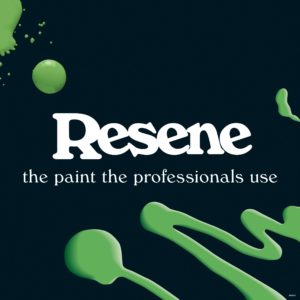A soft grey-blue tonal scheme suits either an urban setting or one by the sea. These weatherboards are in Resene Half Periglacial Blue, the trims are Resene Alabaster and the front door is in Resene Blue Night. The deck has been stained in Resene Woodsman Driftwood.You’re standing there, squinting in the bright New Zealand sun, looking at a house badly in need of a repaint and a colour update. It’s easy to become frozen with indecision when faced with such a daunting task as repainting the house – it’s just so big – but here are some tips from Resene on how to approach your colour choices.
Often the style of your house will dictate the types of Resene exterior colours you use: heritage tones for a villa, soft gelato shades for an Art Deco stucco cottage or brooding black for a contemporary masterpiece.
The first piece of prep work is to identify which bits of the house will carry a paint or other type of finish (e.g. stained timber) and which of those should be the same colour. For example, with an older character home, there may be weatherboards, base boards or a concrete/stucco base, veranda boards, window frames, barge boards, fretwork and the front door. Do you want the window surrounds to be all the same colour or will the inner window frame and/or sill be picked out in a different shade?
For other types of houses, identify which surfaces won’t or can’t be changed. You may, for example, be working with existing aluminium or powder-coated window colours. Or the roof colour may be permanent. There may be brick or timber areas that won’t be changing. Also consider the guttering and spouting colour; you may end up with a smart new dark scheme… ruined by white plastic downpipes slicing through it.
Next, take a walk around the neighbourhood or areas with similar housing styles to yours to gain inspiration. Many successful colour schemes have been passed on simply by having someone knock on a door to ask. Don’t be shy – if you see something you like, ask.
Keep a scrapbook of ideas and colours you love, to get a feel for your own style and preferences. Look online at sites like www.habitatbyresene.co.nz and www.resene.co.nz/inspirations for inspiration. Overseas sites may be less helpful, as New Zealand housing styles are quite different.
Colours that have a greyed quality are good for exteriors as they blend more readily into their surroundings. Soft true greys and warm greys have been fashionable in recent years. Slate blues and greens always look great in a country like ours, surrounded by sea and with our clear blue skies.
Where your house is situated may influence your colour choices. If you’re in a rural situation, soft grey greens may look best, or stormy blues for coastal homes. If you’re in a new subdivision or development, check there are no covenants covering what types of colours you can use.
Top tip: A tried-and-true method for developing a colour scheme centres on three or four colours – one for the main body of the house, another for the trims and another for the roof. The fourth is an accent that might be used on the fence. You might also choose a fifth colour for a striking front door.
Be aware that dark colours absorb more of the sun’s heat and can put stress on the cladding. With any darker colour, consider using the Resene CoolColour range, formulated with special pigment technology to reflect more of the sun’s energy. This keeps the coating and substrate cooler, reducing the likelihood of heat damage such as warping.
Always test your colour with a Resene testpot, as colours change depending on what they are painted onto and the quality of the light. Colours usually look much lighter outdoors, especially in our strong sunlight – if in doubt you may need to choose the darker option. They also change if you put them beside other colours: a grey roof makes green walls look fresher, and a high-gloss finish (rather than a low sheen finish) renders a colour brighter. Contrasts make a colour scheme more interesting, but only highlight details if they deserve the focus. If you’d like a neutral palette, make sure there is sufficient difference between the colours so that you aren’t left with an all-white looking house when the sun is shining.
Remember to test your colours on all sides of the house – the side that faces the northern sun, but also the shady south side. Paint a testpot onto large A2 card leaving an unpainted border around the edge, then once dry move it around from wall to wall at different times of the day so you can see how it looks with different natural lighting.
If you get stuck, take advantage of Resene’s free online colour advice, www.resene.co.nz/colourexpert or make a booking to meet with one of the Resene colour specialists.


